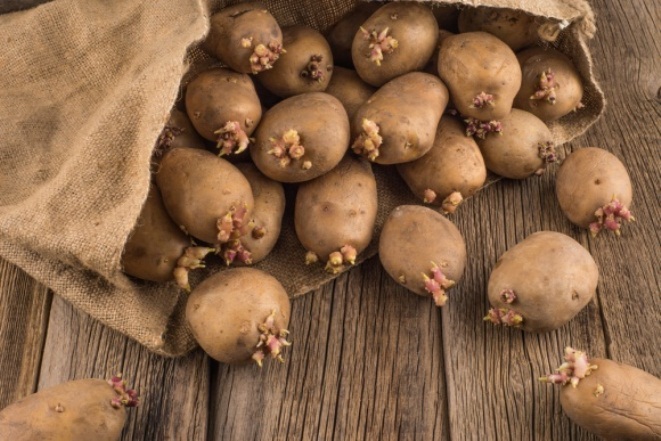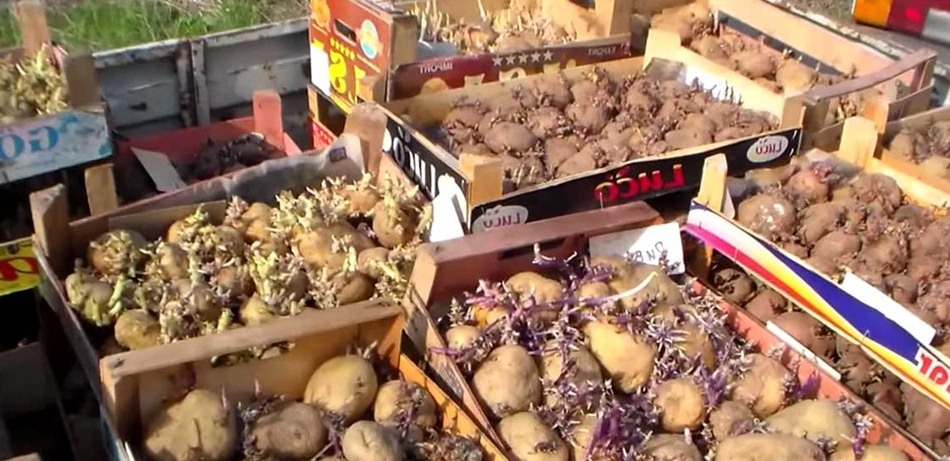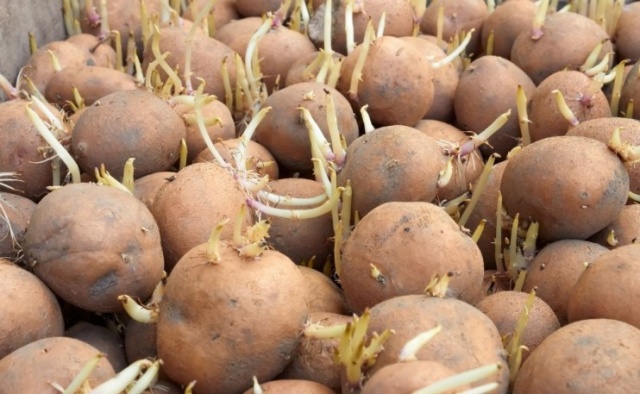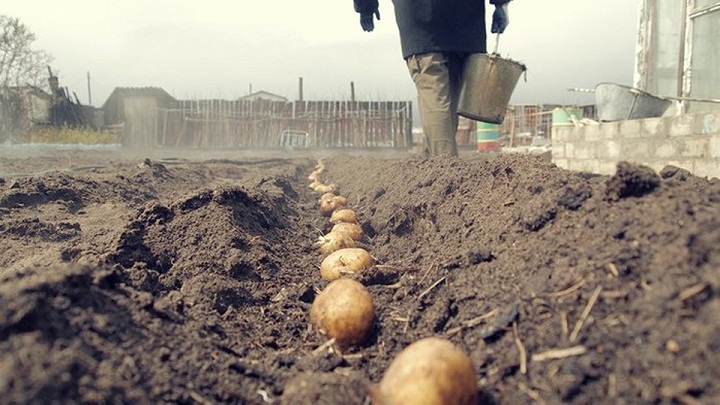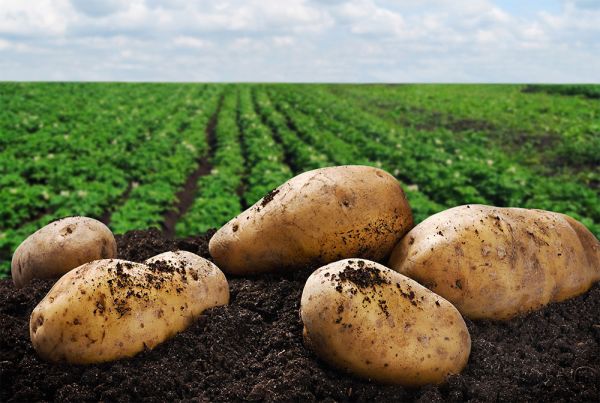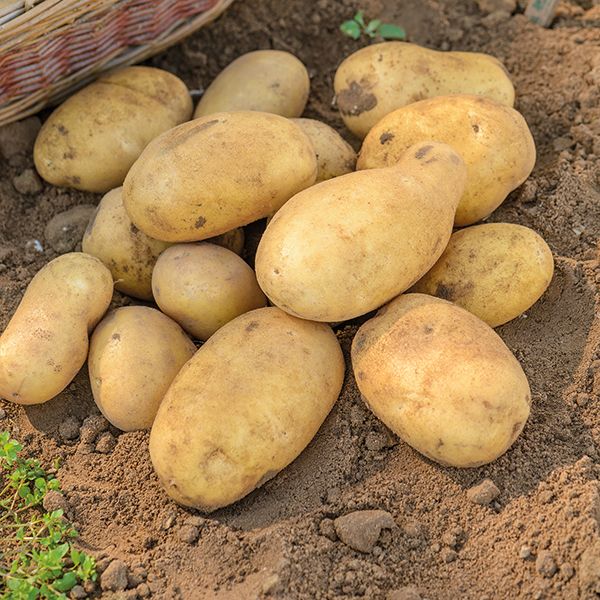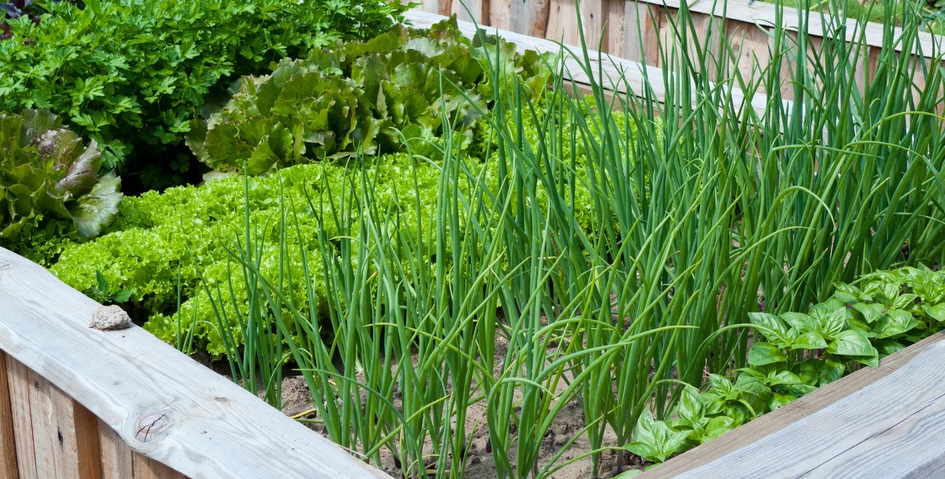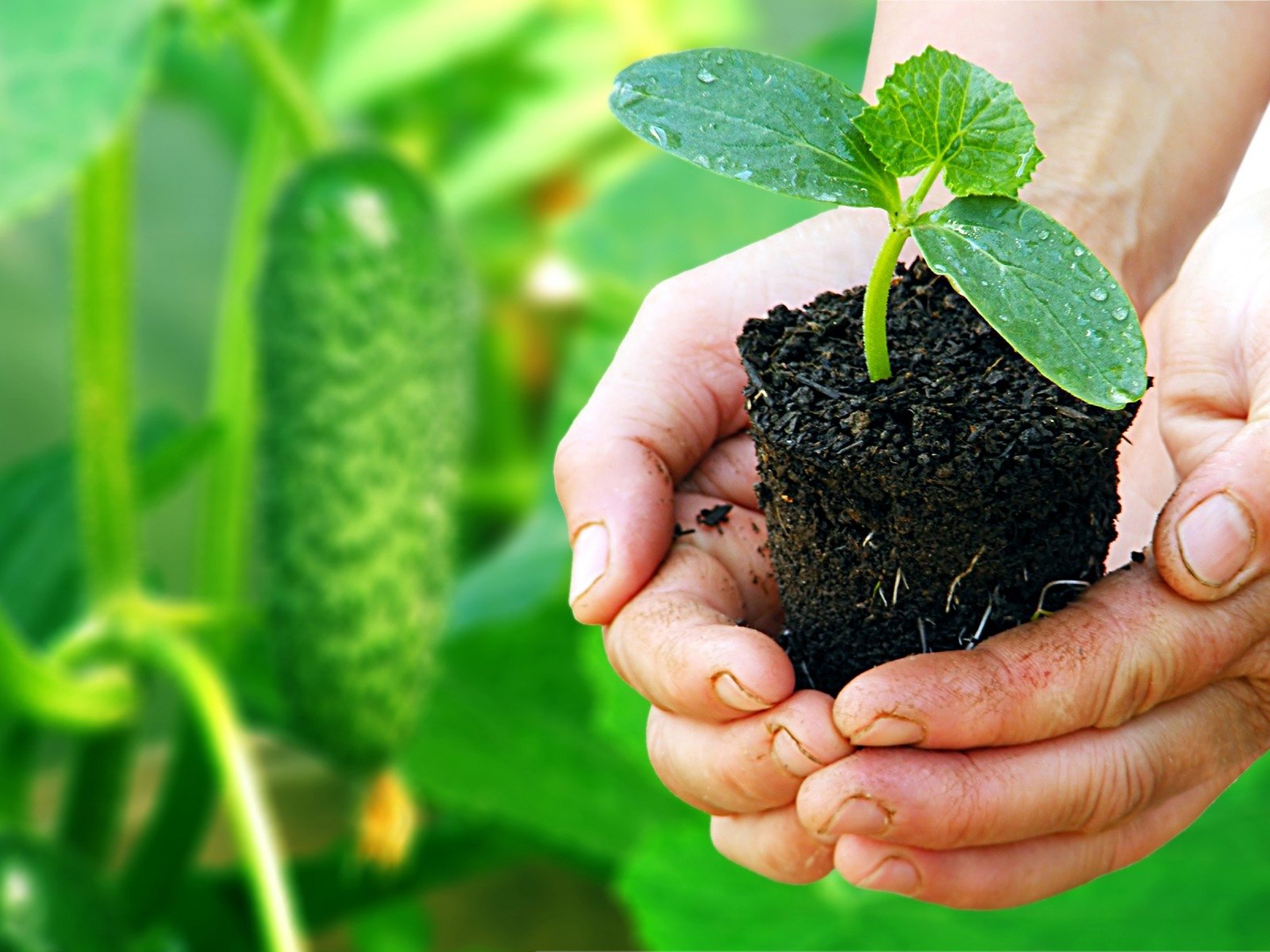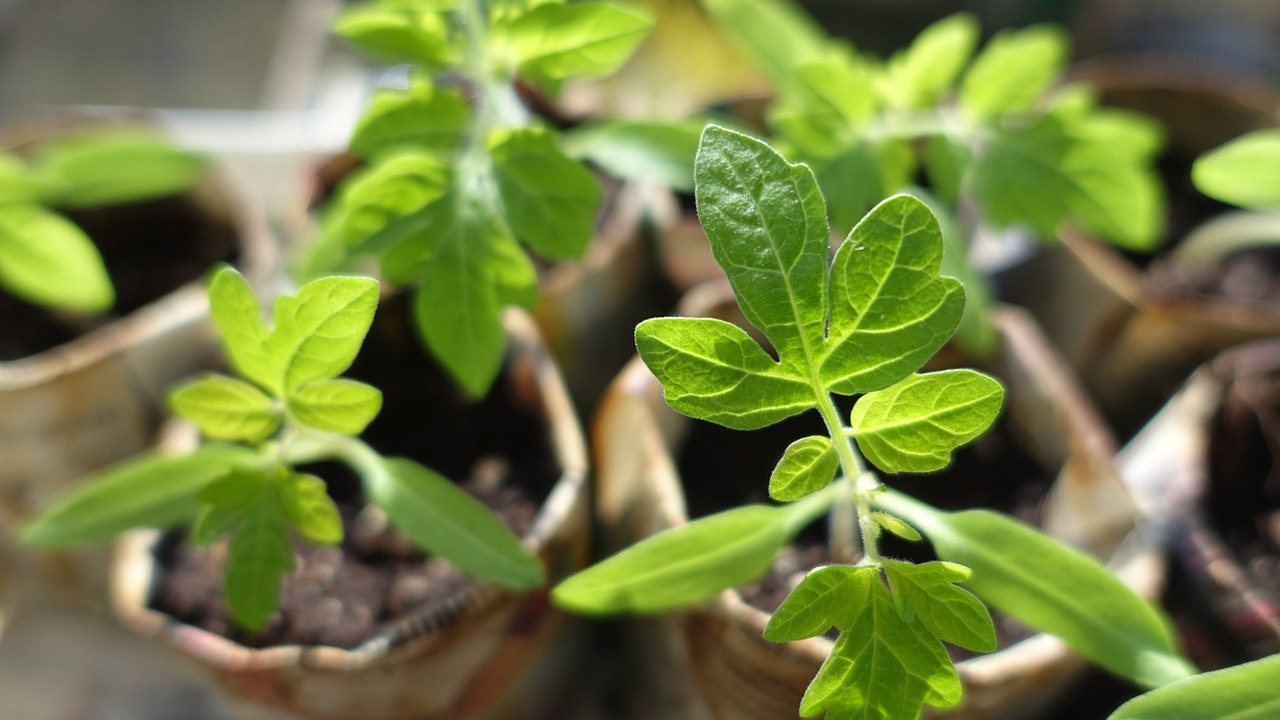Content:
What will be the harvest of potatoes in the next season depends on many factors: weather conditions, pest activity, care, method and time of planting, the selected seed. First, you need to prepare potatoes for planting, you need to decide how to process the potatoes before germinating for planting, how to germinate the potatoes, and only then plant them. The beginning of the process in the Moscow region is early spring. Preparation begins a month before planting in the ground.
General information about culture
Potato (Solanum tuberosum) - perennial in nature, but annual during cultivation, herbaceous plant, with a bush height of up to 65 cm. Rod, with a developed root system. The roots are white. At their ends, tubers are formed, which are used for food. The stem is erect, spreading bush.
The leaves are dissected, with three to four leaflets. The flowers are white or purple, depending on the variety, collected in inflorescences. Fruits - in the form of a dark purple berry, poisonous. Seeds are small, yellow. The color of the edible tubers is different: white, purple, red and yellow.
Selection of root crops for seeds
The main goal of any person engaged in agriculture is a reward for their labor in the form of a rich and high-quality harvest. The first stage begins in the fall, after the potatoes are dug out of the ground. Gardeners with selective breeding skills select the sprawling shrubs with lots of bright tops. When digging, the roots of these bushes are folded into separate boxes. With the help of them, selection is made - the removal of the bushes least susceptible to diseases and pests.
In the spring, if organic seed is picked in the fall, it must be prepared for planting, even with good winter maintenance. When to get the boxes for processing potatoes before planting from the basement, how to sprout harvested potatoes, each gardener determines for himself, depending on the home region.
The process should start by re-grading the tubers. Usually this procedure is carried out where the potatoes have wintered: a basement, an underground or a garage. During storage, tubers can acquire properties that will prevent an increase in last year's yield. In this case, they get rid of them if:
- Small roots, less than 30 g;
- Rot or musty odor
- In the case of a plaque that can be seen with the naked eye, these are traces of pathogenic bacteria.
Next, the roots are sorted by weight and size:
- 30-50 g - small;
- 50-80 - medium;
- 80 years and above - large.
The weight of potatoes is approximate here, because do not weigh each unit. This will take an unreasonably long time. The size of the fruit can be determined by eye; if desired, any gardener will be able to sort the seed harvested in the fall into three parts. Separation of potatoes is required. Without it, during the growth process, weaker shoots will be clogged with stronger ones. Subject to improved selection or an increase in the number of root crops of a rare variety, mixing potatoes of small and medium sizes is allowed.
If a summer resident breeder has several copies of a rare or unique potato variety, he tries to increase their number year after year. In this case, the resulting wealth is stored separately, it is looked after, and all the material is used for planting, without exception.
Preliminary preparation objectives
The main goal of preparing seeds for the sowing period is to obtain a rich and tasty harvest. Untreated potato tubers placed in the soil will germinate after 20 days at the earliest. Provided that pre-treatment is carried out according to all agronomic rules, the emergence of sprouts will significantly accelerate.
The rules are simple:
- Putting potatoes in the light;
- Treatment of potatoes before germination with stimulants in the form of aqueous solutions based on various substances for better growth;
- Withering potatoes.
What actions are recommended:
- Remove potatoes from winter storage;
- Sort out root crops, get rid of substandard;
- Clearing the ground - this will kill the bacteria surviving from the last season;
- Place the potatoes for soaking in a special disinfection solution for a quarter of an hour;
- Dry the root vegetables in a dry, dark place after soaking;
- Place the dried material in a room with a temperature of about 25 ° C.
These steps are called pre-planting potatoes. Now you can start processing. There are several ways to do this.
Germination with light
This method requires the presence of light. In this case, constant lighting of the potatoes is not required. Without lighting in rooms with the correct humidity and temperature, sprouts will actively germinate, but they will be lifeless, thin and long. At the same time, the root crop itself will become soft and weak, because all the strength from him will be sucked out by these useless processes.
For such purposes, any room with access to indirect sunlight and a constant temperature around 15 ° C is suitable. Indirect sunlight allows thick, dark sprouts to form on the potatoes. This condition is best met if the seed is placed in wooden boxes with ventilation holes. To avoid direct sunlight, the boxes are covered with white cloth or newsprint.
Insufficiently lit with natural light, a room is illuminated artificially. To do this, turn on the electric light every day for 9 hours (the illusion of daylight hours is created). The germination period of potatoes depends on the ambient temperature:
- 12 ° C - germination will take about 1.5 months;
- 8 ° С - germination can be delayed up to 2 months;
- 18 ° С - germination will occur in 1 month;
- 20 ° C - critical temperature: the shoots will be unviable, and the tuber will die.
To accelerate the germination of potato tubers, use the following tricks:
- Spray the potatoes with a nutrient solution. This solution is prepared by mixing 10 liters of water and 2 g of manganese. A week later, a new ash-based solution is made: 100 g of wood ash is dissolved in 4 liters of water. Then filter and spray;
- Ambient temperature control. In the first 10 days, the temperature is kept around 18 ° C. Then it is necessary to lower the temperature to 14 ° C and maintain it for another 20 days. By this time, potato sprouts reach 2 cm;
- A couple of days before the seeds are planted in the soil, they must be covered with a dark opaque cloth, and the temperature must be lowered to 12 ° C for hardening.
Use of a wet substance
This method is less labor-intensive, but the results of pre-sowing preparation are very good. In contrast to the previous method, darkness is used here. A mixture of sawdust and peat is used as soil. To begin with, polyethylene is placed in the box, potatoes are placed on top. The polyethylene is cut or punctured in several places. Unnecessary moisture will escape through the slots. The main goal is to create the necessary moisture for the tubers. Sprinkle the potatoes on top with a sawdust-peat mixture with the addition of humus.
For good germination, the following conditions are required:
- The ambient temperature should be within 15-25 ° С;
- Potato ventilation;
- Required environment humidity.
It is required to moisten the natural earth layer with the correct nutrient solution: 2 g of copper sulfate are diluted in 1 liter of water. The potatoes are laid out at a distance of 10 mm from each other and covered with soil mixture to a height of 30 mm. Then the next layer is laid and again sprinkled with earth for 30 mm. This procedure is repeated until the selected container is completely filled.
In the case of floor placement of potatoes (in piles), it is recommended to make no more than 3 layers. It is also good to add humus between layers. It will maintain a constant temperature regime. This cake should be kept moist at all times. This is achieved by spraying the following mixture: 10 liters of water, 30 g of potassium salts and 60 g of superphosphate. In addition, many gardeners combine methods of germinating potato tubers.
Diseases and pests
Phytophthora is very important for growing potatoes. The plant is quite painful and can be affected by various types of viruses, bacteria, insect pests, worms and parasitic fungi. Here are some of them:
- Late blight is a fungal disease that affects leaves, stems and tubers. It is required to spray the tops with a product containing chemicals;
- Blackleg is a bacterial disease that affects leaves, stems and tubers. It is required to pour potassium permanganate and sprinkle the bushes with wood ash;
- Common scab - affects young tubers. The infected area is sown with lupine for a year, phytosporin can be used;
- Mosaic virus is a viral disease; affects bushes. Chemistry required;
- Wireworm - damages potato tubers. The alternation of planting in one area of potatoes and, for example, sunflower, will help;
- Tuber necrosis is a viral disease that affects tubers. Careful selection of seed is required;
- The Colorado potato beetle is the most famous pest that destroys the leaves of the potato bush. Manual collection of insects and their larvae is required, tar can be used.
